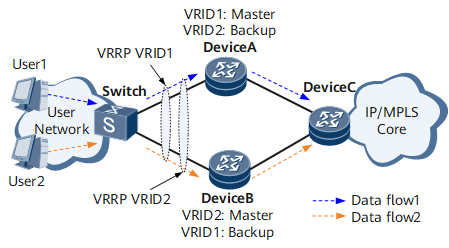Creating a VRRP Group
You can create a Virtual Router Redundancy Protocol (VRRP) backup group and set VRRP priorities to determine the master and backup routers. The master router transmits data traffic. You can create multiple VRRP groups to load-balance data traffic.
Context
VRRP load balancing is classified as multi-gateway load balancing.
Multi-gateway load balancing: Multiple VRRP groups with virtual IP addresses are created and specified as gateways for different users to implement load balancing.
As shown in Figure 1, VRRP groups 1 and 2 are deployed on the network.- VRRP group 1: Device A is the master device, and Device B is the backup device.
- VRRP group 2: Device B is the master device, and Device A is the backup device.
Some users access the Internet using VRRP group 1, and others access the Internet using VRRP group 2. The backup groups can load-balance service traffic and back up each other.

